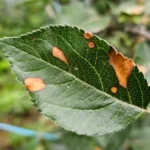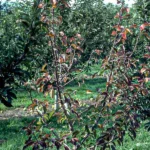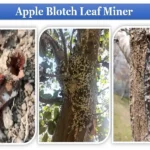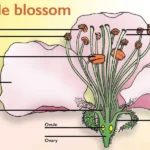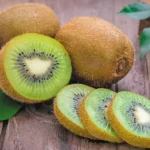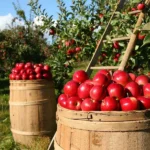Necrotic Leaf Blotch (NLB) is a physiological disorder that primarily affects Delicious apples and their sports. Though not caused by pathogens, this condition can lead to significant defoliation, impacting tree health and fruit quality.
What Is Necrotic Leaf Blotch?
Necrotic Leaf Blotch is a non-infectious physiological disorder characterized by sudden appearance of irregular necrotic blotches on apple leaves. These blotches are typically confined by leaf veins and often lead to premature yellowing and defoliation.
Check our latest Videos
Causes of Necrotic Leaf Blotch
Unlike fungal or bacterial diseases, NLB is not caused by a pathogen. Instead, it’s believed to result from:
- Environmental stress: Hot, dry weather following humid, rainy periods
- Hormonal imbalance: Possibly linked to gibberellin synthesis
- Zinc deficiency: Suspected to play a role in symptom development
Environmental Stress Factors Behind Necrotic Leaf Blotch
Necrotic Leaf Blotch is closely tied to fluctuating weather conditions and other abiotic stressors that disrupt normal leaf physiology. These factors don’t introduce pathogens but instead trigger internal imbalances that manifest as leaf damage.
Temperature Extremes
- Sudden heat waves following cool, wet periods can accelerate gibberellin synthesis, leading to blotch formation.
- High daytime temperatures combined with cool nights stress leaf tissues, especially in Golden Delicious varieties.
Moisture Imbalance
- Heavy rainfall followed by dry spells creates a cycle of hydration and dehydration that weakens leaf cells.
- High humidity promotes rapid leaf expansion, making tissues more vulnerable to necrosis when conditions shift.
Wind and Sun Exposure
- Strong winds can cause mechanical damage and increase transpiration, leading to water stress.
- Intense sunlight on defoliated branches raises the risk of sunburn on exposed fruit, compounding the impact of NLB.
Soil and Nutrient Stress
- Poor soil drainage or compaction reduces root oxygenation, indirectly stressing foliage.
- Zinc and manganese deficiencies, often exacerbated by environmental conditions, are linked to increased blotch severity.
Growth Spurts and Hormonal Imbalance
- Environmental triggers can cause rapid vegetative growth, which may overwhelm the tree’s hormonal regulation and lead to blotch symptoms.
This is especially common in orchards with excess nitrogen fertilization during erratic weather
This disorder is most prevalent in mid to late summer, often appearing in waves throughout the growing season.
Symptoms to Watch For
- Irregular brown blotches on mature leaves
- Yellowing (chlorosis) within 4–7 days of blotch appearance
- Sudden defoliation, especially in the lower third of shoots
- No fungal spores present, distinguishing it from diseases like Glomerella Leaf Spot
Affected trees may lose 10–50% of their foliage, depending on severity.
Read Article about Root Rot
Diagnosis Tips
To differentiate NLB from similar conditions:
| Feature | Necrotic Leaf Blotch | Glomerella Leaf Spot |
| Cause | Physiological | Fungal (Colletotrichum spp.) |
| Lesion Appearance | Irregular, vein-bound blotches | Concentric rings with purple borders |
| Defoliation Pattern | Sudden, lower canopy | Gradual, upper canopy |
| Fruit Impact | Indirect (sunburn risk) | Direct (fruit rot) |
Management Strategies
While there’s no cure, several practices can reduce NLB severity:
- Fungicides with zinc ions: Ziram and mancozeb have shown effectiveness
- Foliar sprays: Zinc oxide and manganese applications help mitigate symptoms
- Cultural practices:
- Prune trees to a central leader rather than open center
- Maintain moderate annual fruit crop to reduce stress
- Use M9 or M26 rootstocks for lower susceptibility
Impact on Orchard Health
Though NLB is considered a minor disorder, severe defoliation can:
- Reduce photosynthesis
- Increase risk of fruit sunburn
- Affect fruit size and quality
Monitoring and timely intervention are key to maintaining orchard productivity.
Author: Dr. Syed Samiullah
Ph.D. Fruit Science
Founder: Temperate Farming



